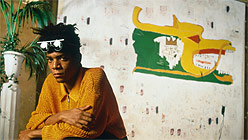In 1986, Tamra Davis, an up and coming young filmmaker, taped an interview with artist Jean-Michel Basquiat, then at the height of his fame. Two years later, Basquiat was dead and Davis put the interview, along with footage she shot of the painter working in his L.A. studio, in storage, where it remained unseen for twenty years. Davis’s new documentary, Jean-Michel Basquiat: The Radiant Child, resurrects that footage to frame the story of Basquiat’s short life. Though the film begins with a prologue that appears as a nod to PBS, quoting the poetry of Langston Hughes and showing footage, set to a be-bop score, of Basquiat at work, the movie really kicks in after this overly bouncy title sequence.
A beat drops and early hip hop dominates the soundtrack, while gritty footage of late ’70s New York sets the mood. Fab 5 Freddy describes the city post “white flight,” infamous blackouts, trash strikes and a bankruptcy. It is a place of possibility, attracting young artists to a developing downtown art and music scene with — get this — cheap rents (!) on Manhattan’s lower east side. Davis may have come up in Los Angeles, but she was certainly connected to this group of artists developing early rap, hip hop, punk and graffiti art, the energy of which fed the rapid rise of commercial youth culture, symbolized by MTV and the ’80s art boom.
Basquiat was among New York’s “Downtown 500” — a group of people who were making music and art and creating a scene, while living fairly hard-scrabble lives in cheap SOHO and Alphabet City apartments. Just 17, and a recent runaway, he began creating graffiti (with Al Diaz) under the name SAMO (“Same Old Shit”). Their graffiti was decidedly different from the usual tagging. Often appearing in the form of lists or questions, SAMO graffiti playfully interrogated politics, economics and religion, and intrigued the downtown crowd, as did the mystery surrounding SAMO’s identity. When Basquiat revealed himself as SAMO, he was already an underground star. Next, he formed a band with the most perfect name ever: GRAY. But his existence remained tentative. He may have survived by surfing the couches of a number of girlfriends…

Davis’s film captures the vitality of this moment and makes you yearn to be there among these downtown denizens, most of whom — Kenny Scharf, Keith Haring, Fab 5 Freddy, Debbie Harry, Glenn O’Brien, Suzanne Mallouk — would go on to successful and often groundbreaking art and music careers of their own. The film is not nostalgic, but somehow, with its gritty sense of possibility, it feels like life was easier back then. Though, of course, Basquiat describes a period when he basically lived on Cheez Doodles. He began making postcard collages and t-shirts to sell in Washington Square Park. Most famously, Basquat spotted Andy Warhol at lunch with Henry Geldzahler and approached the famous artist, convincing him to purchase a couple cards.



